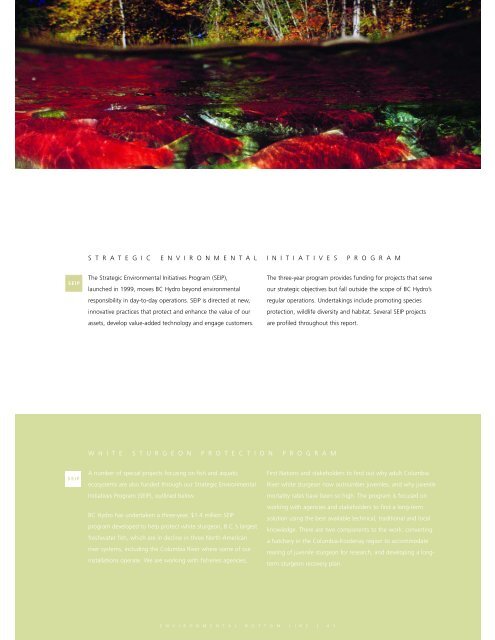2001 Triple Bottom Line Report - BC Hydro
2001 Triple Bottom Line Report - BC Hydro
2001 Triple Bottom Line Report - BC Hydro
Create successful ePaper yourself
Turn your PDF publications into a flip-book with our unique Google optimized e-Paper software.
SEIP<br />
SEIP<br />
S T R A T E G I C E N V I R O N M E N T A L I N I T I A T I V E S P R O G R A M<br />
The Strategic Environmental Initiatives Program (SEIP),<br />
launched in 1999, moves <strong>BC</strong> <strong>Hydro</strong> beyond environmental<br />
responsibility in day-to-day operations. SEIP is directed at new,<br />
innovative practices that protect and enhance the value of our<br />
assets, develop value-added technology and engage customers.<br />
W H I T E S T U R G E O N P R O T E C T I O N P R O G R A M<br />
A number of special projects focusing on fish and aquatic<br />
ecosystems are also funded through our Strategic Environmental<br />
Initiatives Program (SEIP), outlined below.<br />
<strong>BC</strong> <strong>Hydro</strong> has undertaken a three-year, $1.4 million SEIP<br />
program developed to help protect white sturgeon, B.C.’s largest<br />
freshwater fish, which are in decline in three North American<br />
river systems, including the Columbia River where some of our<br />
installations operate. We are working with fisheries agencies,<br />
E N V I R O N M E N T A L B O T T O M L I N E | 4 3<br />
The three-year program provides funding for projects that serve<br />
our strategic objectives but fall outside the scope of <strong>BC</strong> <strong>Hydro</strong>’s<br />
regular operations. Undertakings include promoting species<br />
protection, wildlife diversity and habitat. Several SEIP projects<br />
are profiled throughout this report.<br />
First Nations and stakeholders to find out why adult Columbia<br />
River white sturgeon now outnumber juveniles, and why juvenile<br />
mortality rates have been so high. The program is focused on<br />
working with agencies and stakeholders to find a long-term<br />
solution using the best available technical, traditional and local<br />
knowledge. There are two components to the work: converting<br />
a hatchery in the Columbia-Kootenay region to accommodate<br />
rearing of juvenile sturgeon for research, and developing a longterm<br />
sturgeon recovery plan.
















